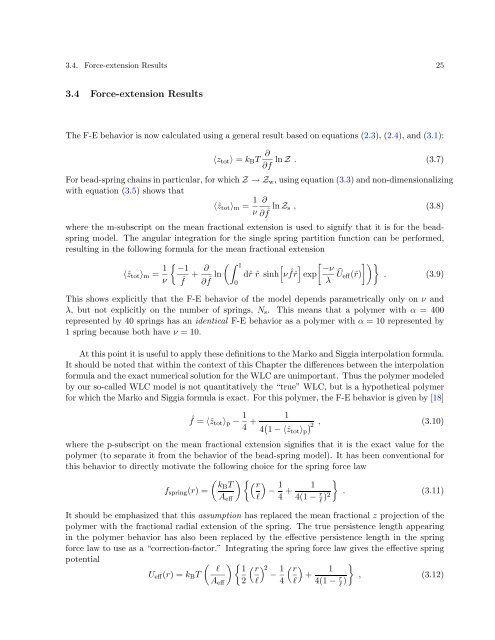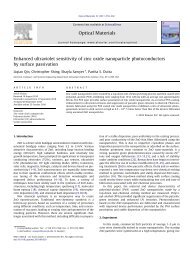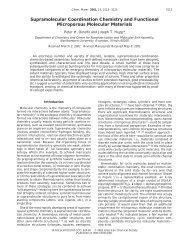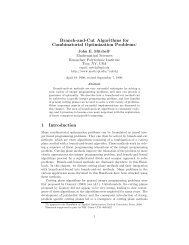Systematic development of coarse-grained polymer models Patrick ...
Systematic development of coarse-grained polymer models Patrick ...
Systematic development of coarse-grained polymer models Patrick ...
Create successful ePaper yourself
Turn your PDF publications into a flip-book with our unique Google optimized e-Paper software.
3.4. Force-extension Results 25<br />
3.4 Force-extension Results<br />
The F-E behavior is now calculated using a general result based on equations (2.3), (2.4), and (3.1):<br />
〈ztot〉 = kBT ∂<br />
ln Z . (3.7)<br />
∂f<br />
For bead-spring chains in particular, for which Z→Zw, using equation (3.3) and non-dimensionalizing<br />
with equation (3.5) shows that<br />
〈ˆztot〉m = 1 ∂<br />
ν ∂ ˆ f ln Zs , (3.8)<br />
where the m-subscript on the mean fractional extension is used to signify that it is for the beadspring<br />
model. The angular integration for the single spring partition function can be performed,<br />
resulting in the following formula for the mean fractional extension<br />
〈ˆztot〉m = 1<br />
<br />
−1 ∂<br />
+<br />
ν ˆf ∂ ˆ f ln<br />
1 <br />
dˆr ˆr sinh ν<br />
0<br />
ˆ <br />
−ν<br />
f ˆr exp<br />
λ <br />
Ueff(ˆr)<br />
. (3.9)<br />
This shows explicitly that the F-E behavior <strong>of</strong> the model depends parametrically only on ν and<br />
λ, but not explicitly on the number <strong>of</strong> springs, Ns. This means that a <strong>polymer</strong> with α = 400<br />
represented by 40 springs has an identical F-E behavior as a <strong>polymer</strong> with α = 10 represented by<br />
1 spring because both have ν = 10.<br />
At this point it is useful to apply these definitions to the Marko and Siggia interpolation formula.<br />
It should be noted that within the context <strong>of</strong> this Chapter the differences between the interpolation<br />
formula and the exact numerical solution for the WLC are unimportant. Thus the <strong>polymer</strong> modeled<br />
by our so-called WLC model is not quantitatively the “true” WLC, but is a hypothetical <strong>polymer</strong><br />
for which the Marko and Siggia formula is exact. For this <strong>polymer</strong>, the F-E behavior is given by [18]<br />
ˆf = 〈ˆztot〉p − 1<br />
4 +<br />
1<br />
4 2 ,<br />
1 −〈ˆztot〉p<br />
(3.10)<br />
where the p-subscript on the mean fractional extension signifies that it is the exact value for the<br />
<strong>polymer</strong> (to separate it from the behavior <strong>of</strong> the bead-spring model). It has been conventional for<br />
this behavior to directly motivate the following choice for the spring force law<br />
<br />
kBT<br />
r <br />
fspring(r) =<br />
−<br />
ℓ<br />
1<br />
4 +<br />
<br />
. (3.11)<br />
Aeff<br />
1<br />
4(1 − r<br />
ℓ )2<br />
It should be emphasized that this assumption has replaced the mean fractional z projection <strong>of</strong> the<br />
<strong>polymer</strong> with the fractional radial extension <strong>of</strong> the spring. The true persistence length appearing<br />
in the <strong>polymer</strong> behavior has also been replaced by the effective persistence length in the spring<br />
force law to use as a “correction-factor.” Integrating the spring force law gives the effective spring<br />
potential<br />
<br />
ℓ<br />
Ueff(r) =kBT<br />
Aeff<br />
1<br />
2<br />
<br />
r<br />
2 −<br />
ℓ<br />
1<br />
4<br />
<br />
r<br />
<br />
+<br />
ℓ<br />
1<br />
4(1 − r<br />
ℓ )<br />
<br />
, (3.12)







